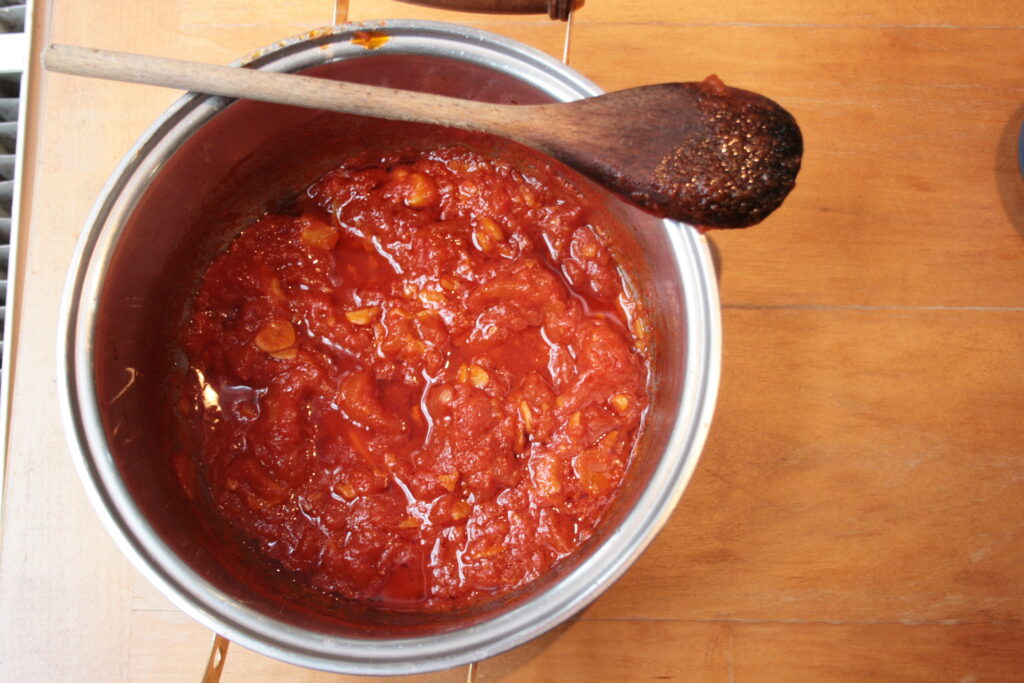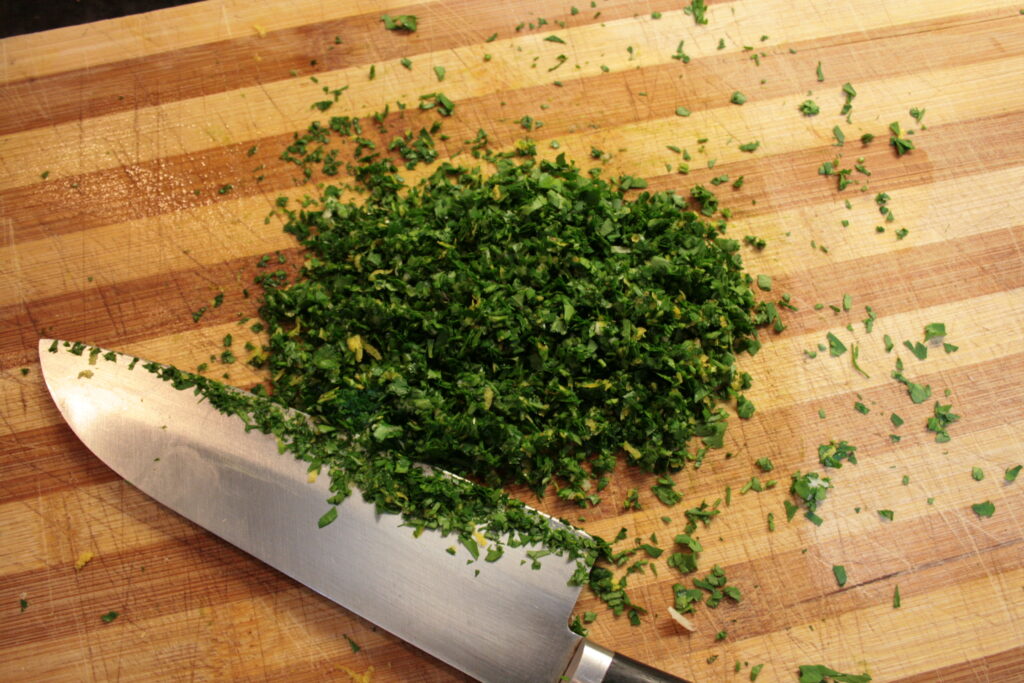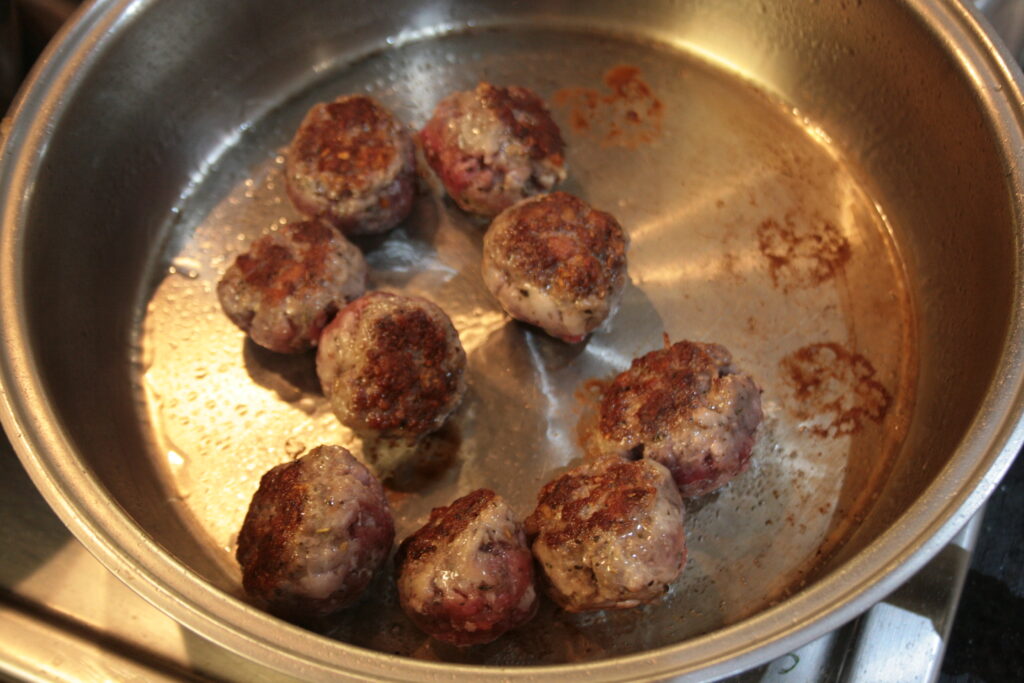By George Ryle, Head Chef at the Garden Museum Café.
George has been head chef at the Garden Café since the Museum re-opened in 2017. In 2018, the Garden Café won the Leading Culture Destinations: Best Restaurant award. While we remain closed during lockdown, George will be sharing some signature Garden Café recipes for you all to try at home.

Pork and fennel meatballs, soft polenta and gremolata
I really love cooking these meatballs, mostly because of how much I love eating them. They never let you down. Ever.
They usually make their way onto the menu at work when we need to use up some odd ends of pork. Often we will buy a loin of pork and either roast it whole, or in half, or cut it into chops. The end of the loin that would have been joined to the shoulder has a bone running through it that makes it less ideal for roasting and chopping so we de-bone it, dice it and mince it. I’d say about seven times out of ten this ends up as meatballs. Always this recipe and, as I mentioned before, always delicious. But if you want to buy your mince, just ask the butcher for pork mince from the shoulder.
Don’t be tempted into thinking that all the flavour and effort for this one is bound up in the meatballs themselves; they need the tomato sauce to be equally amazing – they should sing together. Give the tomato sauce the time that it needs – which is quite a lot. You will be rewarded for your patience. In this instance all of this sits onto of a puddle of comforting polenta, enriched with the two of a cooks most useful weapons – butter and parmesan.
Oregano is one of the few herbs I’d buy dried, but look for good quality oregano, particularly from Sicily or Greece.
For the meatballs
400g pork shoulder mince (lean mince will not work)
1 large clove of garlic
100g parmesan
1/2 teaspoon dried chilli flakes
1 1/2 teaspoons of good quality dried oregano
1 teaspoon of fennel seeds – crushed in a pestle and mortar
For the tomato sauce
2 tins of peeled plum tomatoes
8 cloves of garlic
2 tablespoons of olive oil
For the polenta
125g polenta
500ml of cold water
50g salted butter
75g grated parmesan
For the gremolata:
1 bunch of parsley, leaves picked from the stalks
1 lemon
1 large clove of garlic
If at all possible you should make and roll the meatballs the day before, or maybe early in the morning if you are planning on having them for dinner. They benefit greatly from a rest in the fridge both in terms of their flavour and structure. Tip the mince into a large mixing bowl and add two good pinches of sea salt, the dried oregano, the fennel seeds and the dried chilli flakes. Then using a very fine grater, grate the parmesan and then the garlic clove into the bowl as well.

Mix it all together with you hands, almost kneading it a couple of times – this will help to give them a bit of structure without having to add breadcrumbs or an egg. You will need to give the mix a little try to check for seasoning and I can’t really encourage you to put raw pork in your mouth, so take a little bit and fry it in a pan. Once it is cool, give it a try. Adjust the seasoning as required. Then begin to ball up the mix, aiming for about the size of a table tennis ball. Lay them out on a tray and once all the mix is rolled and put them in the fridge to cool.

This tomato sauce is super simple but does require a lot of time – imagine a farmhouse in Tuscany with a pot of tomato sauce slowly bubbling away on the stove all afternoon, and try to recreate that scene. Start by peeling and slicing all of the garlic. Heat up all the olive oil in a sauce pan, add the garlic and two large pinches of salt and let it cook over a medium heat for about 2 minutes, stirring regularly. ‘Sticky garlic’ is the point that you want to take it to. This is the moment, just before the garlic starts to turn to golden, when the garlic starts to feel sticky when stirred with a wooden spoon – sticking together and sticking to the pan itself. It sounds odd and is quite hard to explain but you will notice it when it happens. When it happens and before the garlic has achieved any colour (the smell at this point will be quite amazing) add the two tins of tomatoes. Fill one of the tins with water and then tip it into the other tin and then tip that into the pan. Give it a stir and turn the heat down low and go and find something else to do for the next 4-5 hours. Do return every 20 minutes of so to give it a stir.
The polenta will take about half an hour to cook. Bring the water, a good pinch of salt and 1 tablespoon of olive oil up to a boil in a medium sized pan. Once boiling pour in the polenta and whisk continuously. To avoid a volcanic like eruption of molten hot polenta, immediately turn the heat down, as it will thicken very quickly! After about two minutes the polenta should be thick like the consistency of mash potato, at this point you can stop stirring continuously and leave it to cook very slowly, returning to stir every 5 minutes.

For the gremolata you will need a sharp knife and a fine grater. At the restaurant we actually chop all of the ingredients, and please do the same if you are so inclined at home. However here I am going to suggest the easy method by enlisting the assistance of a grater. So, finely chop the parsley and leave it in a pile on your chopping board then grate the zest of the lemon and the clove of garlic onto the pile of parsley. Then run your knife through the pile of ingredients making sure that they are all well combined and that there are no clumps of grater garlic. Set aside until later.

Once the tomato sauce is at the point that you are happy with you can start frying your meatballs off. Using a hot pan and a little olive oil, fry the meatballs over a medium heat, turning them frequently so they can colour on all sides (a ball doesn’t really have sides, I know, but you understand what I’m saying, right?). Once they are looking nicely caramelised remove them from the frying pan and put them in a roasting tray or oven proof dish. Repeat until all the balls have been fried. Then tip the tomato sauce all over the meatballs, give them a shake so that the sauce is evenly spread and then bake them in the oven for a further 4-5 minutes.

Finish off the polenta by stirring in the butter and parmesan; again, the consistency of mash potato is what we are aiming for, so add some extra water if it is too thick. Spoon the polenta onto your plate, then the meatballs and sauce on top of that and then sprinkle the gremolata all over it.

—
